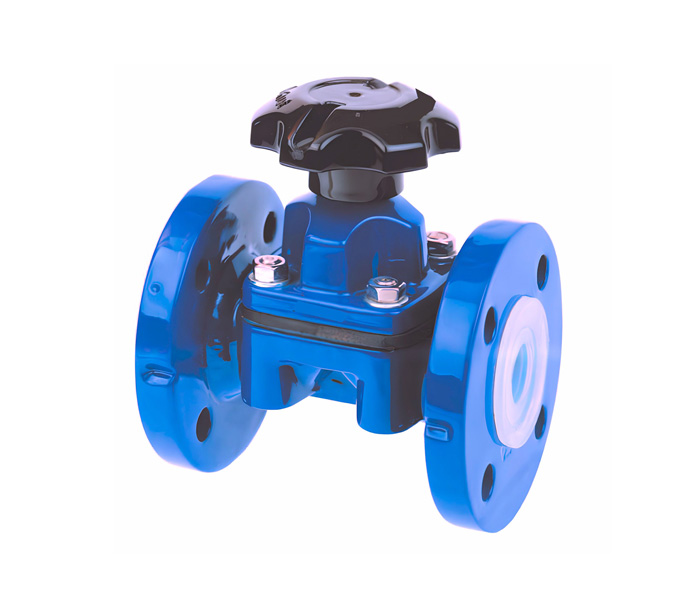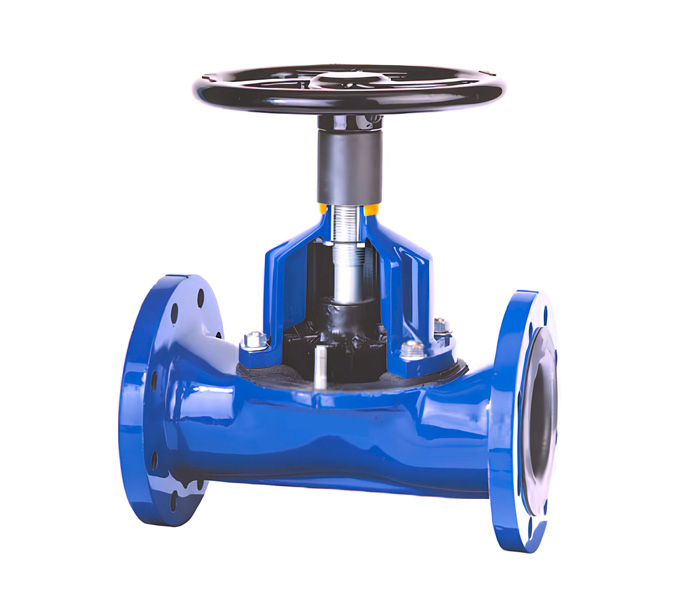





What are Diaphragm valves?
Diaphragm valves are a type of control valve designed to regulate the flow of fluids within a pipeline. They consist of a flexible diaphragm or membrane that is positioned within the valve body. This diaphragm is typically made of materials such as rubber, elastomers, or other flexible materials. The movement of the diaphragm controls the flow of the fluid through the valve. Diaphragm valves can be used to allow, block, or throttle the flow of media.
Product Data
Diaphragm valves are highly versatile and efficient flow control devices used in various industries, including water treatment, chemical processing, and pharmaceuticals. These valves are designed to handle corrosive and abrasive fluids, offering reliable and leak-tight performance. The diaphragm valve operates by the movement of a flexible diaphragm, which opens and closes the valve, providing precise flow control.
Types of Diaphragm Valves
Weir Type Diaphragm Valve: Suitable for applications requiring leak-tight closure and control. The weir design is ideal for clean applications and provides better throttling control.
Straight-Through Diaphragm Valve: Ideal for applications with high flow rates and low-pressure drops. This type is excellent for handling slurries, viscous fluids, and those containing suspended solids.
Specifications
Valve Body Materials:
- Stainless Steel (SS 304/L, SS 316/L)
- Carbon Steel
- Duplex Stainless Steel
- Super Duplex Stainless Steel
Sizes: 15 mm (½ inch) to 300 mm (12 inches)
Pressure Ratings: Up to 3500 psi (241 bar)
Temperature Range:
- Stainless Steel: -40°C to 121°C (-40°F to 250°F)
Technical Information
Connection Types:
- Flanged (ANSI, DIN, JIS standards)
- Threaded
- Socket weld
Actuation Options:
- Manual
- Pneumatic (single-acting, double-acting)
Design Features:
- Zero Dead Leg: Ensures minimal product retention and contamination.
- Smooth Flow Path: Reduces turbulence and wear, improving valve lifespan.
- Ease of Maintenance: The top-entry design allows for easy maintenance and diaphragm replacement without removing the valve from the pipeline.
- Hygienic Design: Suitable for CIP/SIP applications, meeting high sanitary standards.
Dimensions and Sizes
Flanged Connections (Dimensions in mm)
| Model Number | Size (mm) | A | B | C | D | E |
|---|---|---|---|---|---|---|
| ARO-DV-001-15 | 15 | 130 | 210 | 108 | 140 | 165 |
| ARO-DV-001-20 | 20 | 150 | 210 | 117 | 152 | 190 |
| ARO-DV-001-25 | 25 | 160 | 230 | 127 | 165 | 216 |
| ARO-DV-001-32 | 32 | 180 | 230 | 140 | 178 | 229 |
| ARO-DV-001-40 | 40 | 200 | 260 | 165 | 190 | 241 |
| ARO-DV-001-50 | 50 | 230 | 260 | 178 | 216 | 292 |
| ARO-DV-001-65 | 65 | 290 | 300 | 190 | 241 | 330 |
| ARO-DV-001-80 | 80 | 310 | 340 | 203 | 283 | 356 |
| ARO-DV-001-100 | 100 | 350 | 380 | 229 | 305 | 432 |
| ARO-DV-001-125 | 125 | 400 | 430 | 254 | 381 | 508 |
| ARO-DV-001-150 | 150 | 480 | 500 | 267 | 403 | 559 |
| ARO-DV-001-200 | 200 | 600 | 550 | 292 | 419 | 660 |
| ARO-DV-001-250 | 250 | 730 | 650 | 330 | 457 | 787 |
| ARO-DV-001-300 | 300 | 850 | 775 | 356 | 502 | 838 |
- A: Face-to-face dimension – the overall length of the valve.
- B: Center-to-face dimension – the distance from the centerline of the valve to the face of the flange.
- C: Height to the top of the actuator or handwheel.
- D: Diameter of the handwheel or actuator.
- E: Flange outer diameter.
Applications of Diaphragm Valves
- Chemical Processing: Diaphragm valves are used in the chemical industry for controlling the flow of corrosive and abrasive chemicals. Their resistance to corrosion and ability to handle aggressive fluids make them valuable in chemical processing.
- Water and Wastewater Treatment: Diaphragm valves are employed in water treatment plants for regulating the flow of water, chemicals, and sludges. They are also used in wastewater treatment processes.
- Pharmaceutical and Biotechnology: In pharmaceutical and biotechnological applications, diaphragm valves are preferred for their biocompatible materials. They are used in processes involving the handling of sensitive biological materials.
- Food and Beverage Industry: Diaphragm valves are widely used in the food and beverage industry for applications requiring high sanitary standards. They are suitable for controlling the flow of liquids in the production of food and beverages.
- Mining and Mineral Processing: Diaphragm valves find applications in mining operations for handling slurries and fluids containing solid particles in mineral processing.
- Oil and Gas Industry: In the oil and gas sector, diaphragm valves are used for controlling the flow of crude oil, natural gas, and various hydrocarbons in pipelines and processing facilities.
- Power Generation: Diaphragm valves are employed in power plants to control the flow of steam, cooling water, and other fluids at different stages of power generation.
- Pulp and Paper Industry: In the pulp and paper industry, diaphragm valves are used for controlling the flow of chemicals, slurries, and fluids in various stages of production.
- Automotive Manufacturing: Diaphragm valves find applications in automotive manufacturing processes for controlling fluids and chemicals used in different stages of production.
- Agricultural Irrigation: Diaphragm valves are used in agricultural irrigation systems to control the flow of water to fields and crops.
- Textile Industry: In textile manufacturing, diaphragm valves are employed for fluid control in dyeing and finishing processes.
- Marine Applications: Diaphragm valves are used in marine systems for controlling seawater intake, ballast systems, and other fluid-handling processes on ships and offshore platforms.
- Air Handling Systems: Diaphragm valves find applications in industrial and commercial facilities for regulating the flow of air in ventilation and exhaust systems.
- Chemical Distribution: In chemical distribution systems, diaphragm valves are used for transferring and controlling the flow of various chemicals.
- Fire Protection Systems: Diaphragm valves are employed in fire protection systems for controlling the flow of water in sprinkler systems and hydrants.
Advantages of Diaphragm Valves
- Versatility: Diaphragm valves are versatile and can be used for a wide range of applications, including handling corrosive, abrasive, or viscous fluids, as well as fluids with solid particles.
- Bubble-Tight Seal: Diaphragm valves can provide a tight seal, ensuring minimal or no leakage. This is particularly important in applications where a leak-tight closure is critical.
- Biocompatibility: In industries such as pharmaceuticals and biotechnology, diaphragm valves are preferred for their biocompatible materials, making them suitable for processes involving sensitive biological materials.
- Handling Solids: They are capable of handling fluids with solid particles, such as slurries, without clogging or affecting valve performance.
- Easy to Clean and Sterilize: Diaphragm valves are designed for easy cleaning and sterilization, making them well-suited for applications with high sanitation requirements, such as in the food and beverage and pharmaceutical industries.
- Reduced Maintenance: The simple design of diaphragm valves, with fewer moving parts, often results in reduced maintenance requirements and extended service life.
- Excellent Corrosion Resistance: Depending on the materials used in construction, diaphragm valves can offer excellent corrosion resistance, making them suitable for use in corrosive environments.
- Accurate Flow Control: Diaphragm valves provide precise control over fluid flow, allowing for accurate modulation and throttling.
- Low Pressure Drop: Diaphragm valves typically exhibit a low pressure drop, ensuring efficient flow through the system.
- Wide Range of Materials: They can be constructed from a variety of materials, including plastics, metals, and elastomers, providing compatibility with different fluids and chemical compositions.
- Resilient Design: The flexible diaphragm used in these valves allows for resilience against pressure surges, making them durable in fluctuating operating conditions.
- Ease of Automation: Diaphragm valves can be easily automated using pneumatic, hydraulic, or electric actuators, enhancing their suitability for automated process control systems.
- Wide Range of Sizes: Diaphragm valves are available in various sizes, making them applicable in both small and large-scale industrial processes.
- Isolation Capability: Diaphragm valves can provide effective isolation between the flowing medium and the surrounding environment, reducing the risk of contamination.
